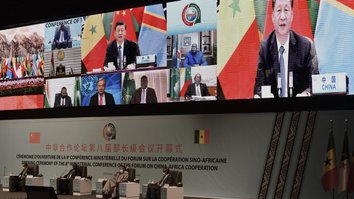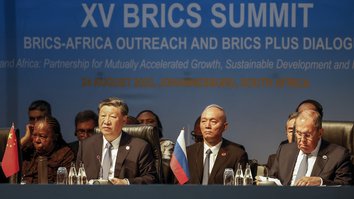WASHINGTON -- As the world's largest official creditor, China has a responsibility to prevent a new international debt crisis sparked by Russia's war in Ukraine, a top US Treasury official said this week.
Developing and emerging markets were already experiencing difficulty at the start of the year, after a 2% fall in their collective outputs following the COVID-19 pandemic, Brent Neiman, a counselor to US Treasury Secretary Janet Yellen, said Tuesday (September 20) at the Peterson Institute for International Economics in Washington, DC.
"Governments, appropriately, borrowed and spent to weather the shock and fight back against the disease," he said, according to a Treasury Department statement. "Their debt levels jumped from 54% of GDP before COVID to 64% by the end of last year."
"And then, at this time of great vulnerability, Russia unleashed its brutal and unjustified war against Ukraine," Neiman said. "The war has caused food and energy prices to jump and accelerated inflation around the world."
These conditions will without a doubt cause "debt distress" in several countries, he said.
He gave the example of Sri Lanka, which is undergoing a major political and economic crisis due in part to Chinese loans and infrastructure projects gone awry.
The lessons learned in Sri Lanka provide a cautionary tale for borrowers of Chinese loans and recipients of Chinese infrastructure projects -- particularly those associated with the Belt and Road Initiative (BRI), also known as One Belt, One Road (OBOR), analysts warn.
Despite being the largest bilateral official creditor in the world, China has delayed or failed to participate in multinational efforts to alleviate borrowing loads, Neiman said.
"China's enormous scale as a lender means its participation is essential," he stressed.
"A recent study estimates that as many as 44 countries now owe debt equivalent to more than 10% of their GDP to Chinese lenders," he said.
Estimates of the total of outstanding Chinese official loans -- while uncertain from a lack of transparency -- range from roughly $500 billion to $1 trillion.
"Failure to act on these debts could imply years of ongoing difficulties with the servicing of debts and with underinvestment and lower growth in low and middle income countries," Neiman said.
Neiman called on Beijing to end the "enormous delays" in participating in the international efforts to provide relief.
The International Monetary Fund (IMF) and the World Bank have made similar pleas, so far to no avail.
Hidden debts
When asked about Neiman's remarks, Chinese Foreign Ministry spokesperson Wang Wenbin punted the blame.
"In recent years, the increasing debt of developing countries has mainly come from Western commercial creditors and multilateral institutions, and developing countries' long-term debt payments have mainly flowed to Western commercial creditors and multilateral institutions," he said, according to Reuters.
China became the world's largest official creditor in 2017, surpassing the World Bank and the IMF, according to a report published in the Journal of International Economics last November.
Researchers highlighted the significance of these "hidden debts" to macroeconomic stability.
"The Chinese government does not report on its official international lending and does not publish any data on outstanding overseas debt claims," they said, adding that "50% of China's official lending to developing countries is not reported in the most widely used official debt statistics."
The countries most in debt to China are primarily located in Africa but are also in Central Asia, Southeast Asia and the Pacific, according to the World Bank.
Analysts point to the BRI as a major source of debt to China for participating countries.
Of the 97 countries participating for which data were available in 2020, those with the highest external debt to China were all involved in the BRI, Forbes and Statista reported in August.
Pakistan, for example, had $77.3 billion of external debt to China, followed by Angola ($36.3 billion), Ethiopia ($7.9 billion), Kenya ($7.4 billion) and Sri Lanka with $6.8 billion in Chinese-held debt.
Djibouti -- a major hub for the BRI and home to one of China's few military bases abroad -- has the biggest external debt burden to China as a percentage of gross national income, at 43%.

![Journalists watch the live broadcast of the arrival of Chinese President Xi Jinping in Samarkand, Uzbekistan, on September 15, for a Shanghai Co-operation Organisation (SCO) summit. i[Alexander Nemenov/AFP]](/cnmi_pf/images/2022/09/23/37252-000_32jf4ey-585_329.jpg)






